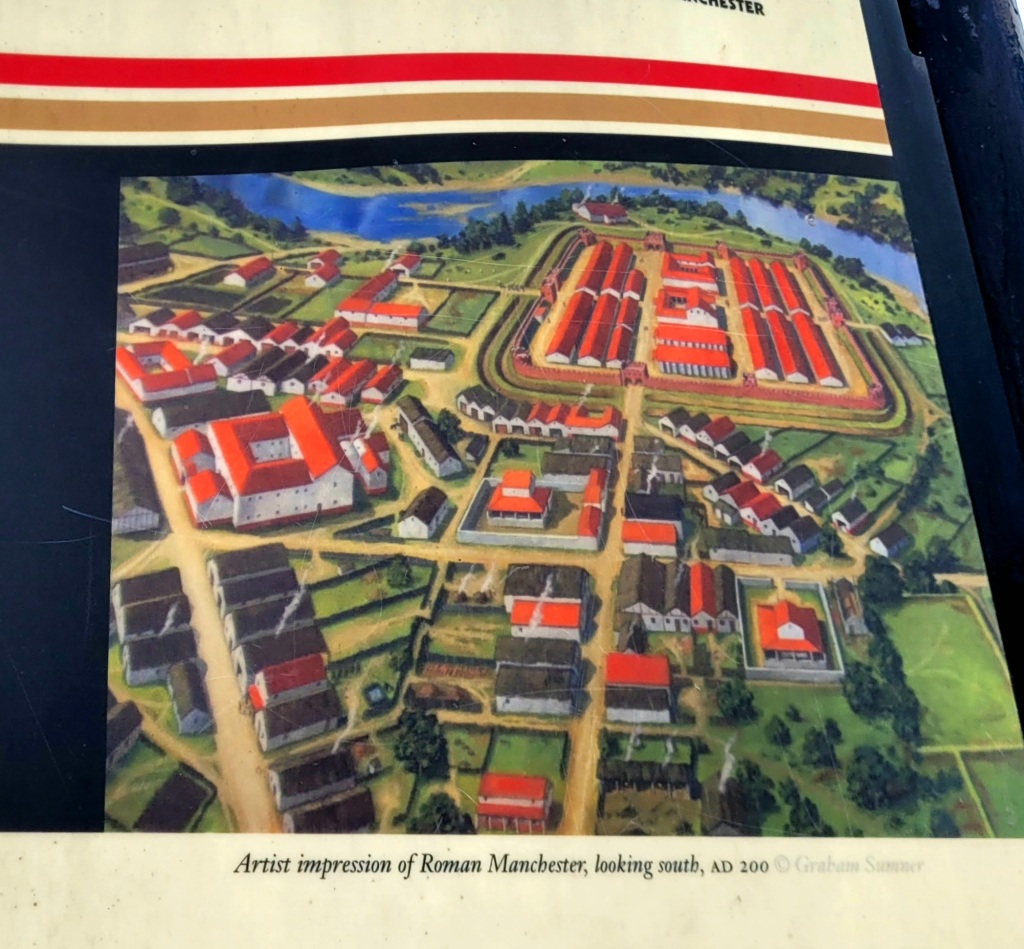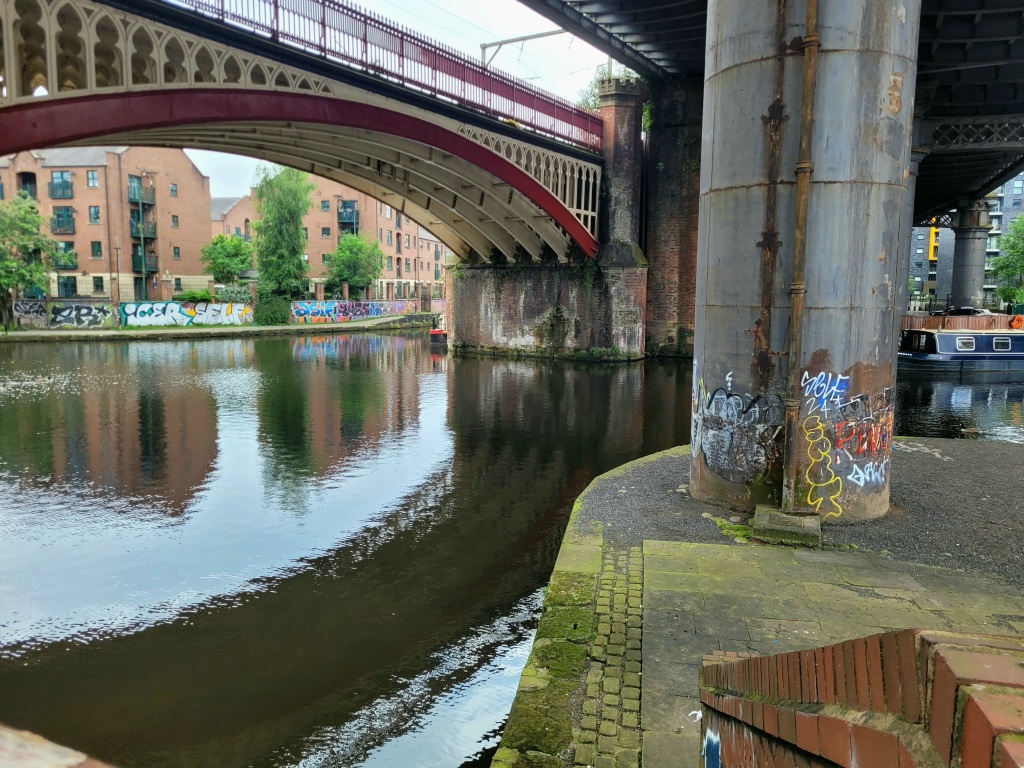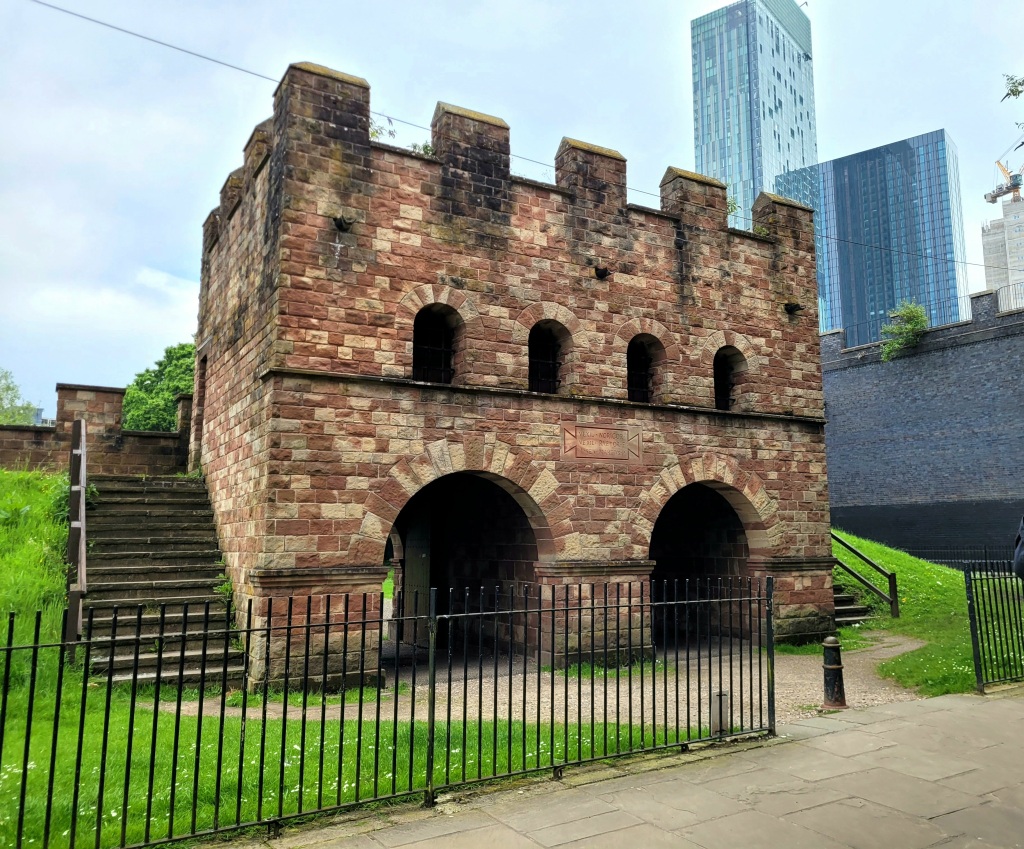
Section Of Mamucium, Manchester, Castlefield , Manchester, note the 19th Viaduct and the present day Sky Scrapers
As a proud Mancunian I have decided to visit and revisit many parts of my city, over the last year or so and what better place to start than the birth place of Manchester itself with the arrival of The Roman Army, in a region now known as Castlefield.



Castlefield Basin, Castlefield, Manchester, UK.
Castlefield today is unrecognisable as the neglected region that I remember as a child. Today it is an inner city conservation area, designated so in 1980 and the United Kingdom’s first designated urban heritage park in 1982. It is bounded by the River Irwell, Quay Street, Deansgate and Chester Road. It was the site of the Roman era fort of Mamucium or Mancunium which gave its name to Manchester. It was the terminus of the Bridgewater Canal, the world’s first industrial canal, built in 1764; the oldest canal warehouse opened in 1779. The world’s first passenger railway terminated here in 1830, at Liverpool Road railway station and the first railway warehouse opened here in 1831.

The Former Liverpool Road Railway Station, Liverpool Road, Manchester, UK.
The name Castlefield refers to the settlement’s position below the former Roman fort. It is a contracted version of the earlier name Castle-in-the-field. The Roman fort (castra), Mamucium or Mancunium was established in what is now Castlefield around AD 79 near a crossing place on the River Medlock. The fort was sited on a sandstone bluff near the confluence of the River Medlock and Irwell in a naturally defensible position. It was erected as a series of fortifications established by Gnaeus Julius Agricola during his campaign against the Brigantes, who were the Celtic tribe in control of most of northern England.

Section Of Mamucium, Castlefield, Manchester, UK.
Built first from turf and timber, the fort was demolished around 140. When it was rebuilt around 160, it was again of turf and timber construction. Around the year 200, the fort underwent another rebuild enhancing its defences by replacing the gatehouse in stone and facing the walls with stone. The fort would have been garrisoned by an infantry cohort of around 500 auxiliary troops.


Section Of Mamucium, Castlefield, Manchester, UK.
Evidence of pagan and Christian worship have been discovered. Two altars have been found and there may also have been a temple of Mithras at the site. In 2008 an altar dating from the late 1st century was discovered near the Roman settlement. It was dedicated to two minor Germanic gods.




Remains Of Mamucium, Castlefield, Manchester, UK.
A word square was discovered in the 1970s that may be one of the earliest evidences of Christianity in Britain. A civilian settlement (vicus) grew in association with the fort, made up of traders and the soldiers’ families. An area which has a concentration of furnaces and industrial activity has been described as an industrial estate. The civilian settlement was probably abandoned by the mid third century, although a small garrison may have remained at Mamucium well into the late third and early fourth centuries. A reconstructed part of the fort stands on the site and is open to the public.


Plaque And Notice Board Explaining Mamucium, Castlefield, Manchester, UK.
There is no evidence that a prehistoric settlement occupied the site before the arrival of the Romans. But Stone Age activity has been recorded in the area, two Mesolithic flints and a flint flake as well as a Neolithic scraper have been discovered. A shard of late Bronze Age pottery has also been found. Although the area was in the territory of the Celtic tribe Brigantes, it may have been under the control of the Setantii, a sub-tribe of the Brigantes, when the Romans took control from the ancient Britons.

Section Of Mamucium Wall, Castlefield, Manchester, UK..
The village of Manchester later became established a kilometre to the north and the area around the vicus became known as “Aldport” or “The Old Town”. The remains of the old town of Aldport, although very densely populated, were demolished at the end of the 19th century to make way for the construction of the Great Northern Warehouse, the ultimate transport interchange building.

Artist‘s Impression Of Roman Manchester Looking South AD 200.
Mamucium was levelled as Manchester became the first Industrial city. Revolution. The construction of the Rochdale Canal through the south western corner of the fort in the late 18th and early 19th centuries, and the building of viaducts for the Great Northern Railway over the site in the late 19th century, damaged the remains and even destroyed some of the southern half of the fort. When the railway viaducts were built, Charles Roeder documented the remains that were uncovered in the process, including parts of the vicus. Mills were all around the site. Castlefield became the south west corner of Manchester city centre. Deansgate, which developed into the main thoroughfare, follows the general line of Roman road to Ribchester.

Views Of Castlefield Basin And Victorian Bridge, Castlefield, Manchester, UK.
The River Irwell was made navigable in 1720s, leading to the construction of a quay in the area for loading and unloading of goods (vessels of up to 50 tons could dock here and ply between Manchester and Liverpool). The Bridgewater Canal arrived in Castlefield in July 1761, around the time the Industrial Revolution is considered to have started.

Castlefield Basin, Castlefield, Manchester, UK.
During the 20th century both canal and railway transport declined and the area became somewhat derelict. The railway complex in Liverpool Road was sold to a conservation group for a nominal £1 and became the Greater Manchester Museum of Science and Industry. In 1982 the area was designated as an urban heritage park and a part of the fort was reconstructed on the excavated foundations. Tourism and leisure are now growth industries which have transformed Castlefield from a neglected corner of the city, with buried remains, to a thriving major attraction with frequent popular events.

Science and Industry Museum, Liverpool Road, Manchester, Greater Manchester UK.
Castlefield Viaduct
The viaduct itself was constructed by Heenan and Froude, the engineers who built the iconic Blackpool Tower. Upon the viaduct’s completion, a local newspaper report declared it ‘a triumph of engineering skill. For the next 77 years the viaduct was used to carry heavy rail traffic in and out of the area, until it finally closed in 1969.
Since its closure, the viaduct has remained a focal feature of the Castlefield skyline, even serving as a backdrop to TV series such as Coronation Street and Peaky Blinders, the latter of which made use of the viaduct’s shadowy archways and looming industrial bulk to evoke 1920s Birmingham.
Castlefield Viaduct is now open as part of a pilot project, this historic structure is now an ‘urban garden’ in the sky. Half of the deck has been planted with trees, flowers and shrubs, creating a green space for visitors to unwind in, and learn more about the city’s long relationship with plants and trees.







Castlefield Viaduct, Castlefield, Manchester, UK.
How wonderful it is to stand up there amongst the battements of Mamucium, and as you do so and gaze into the distance looking towards the Victorian viaduct and the skyscape of Beetham Tower. And as you do so, just imagine yourself nearly two thousand years ago as a garrison soldier on look out duty and imagine what he would have thought if he could see what you can see.

Section Of Mamucium, Castlefield, Manchester, UK.
I first became aware of the importance of Castlefield and the evidence of pagans, and the worship of Mithras whilst researching my ghost novel, The Haunting Of Barrack Walk amazing inspiration for future writing don‘t you think?
